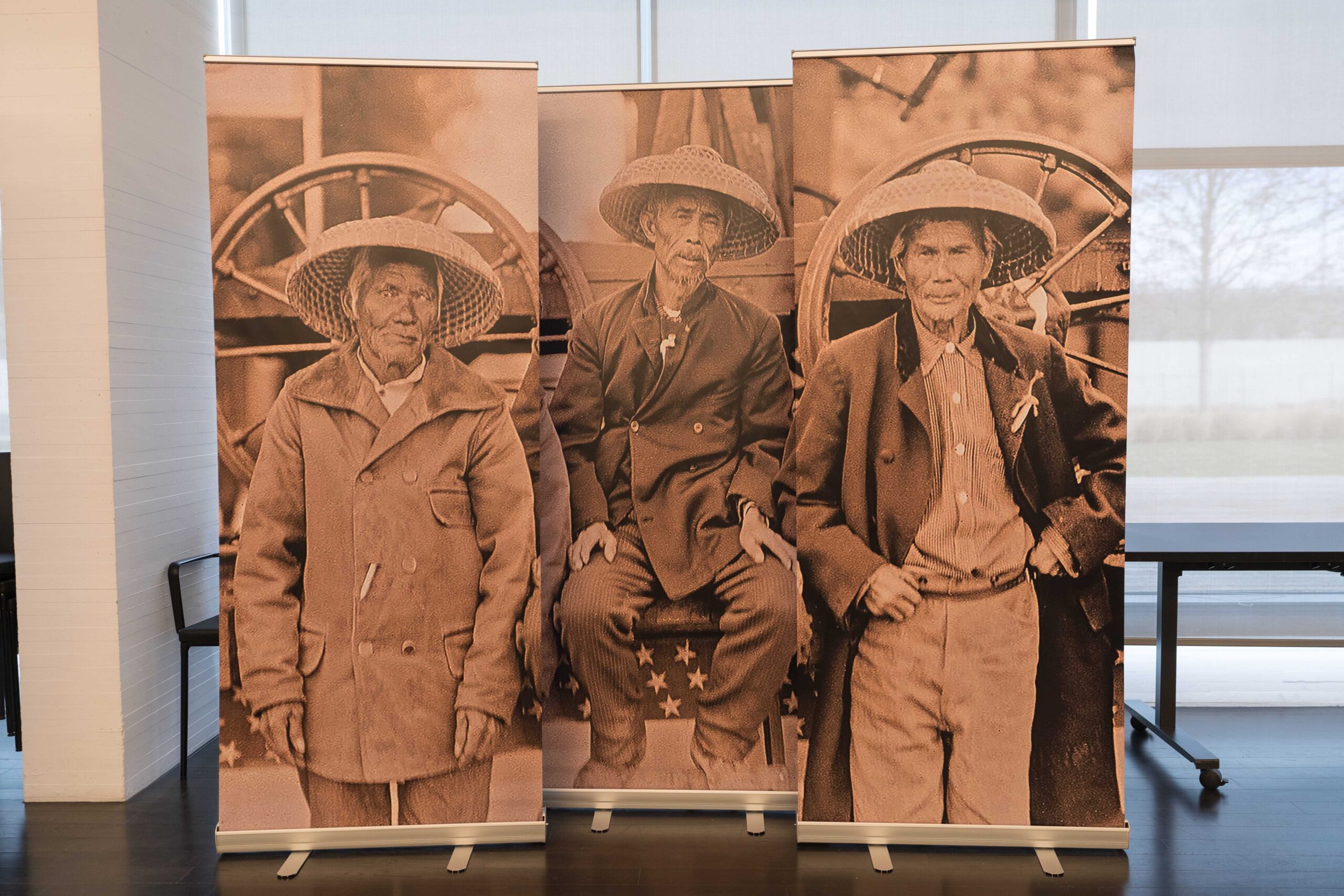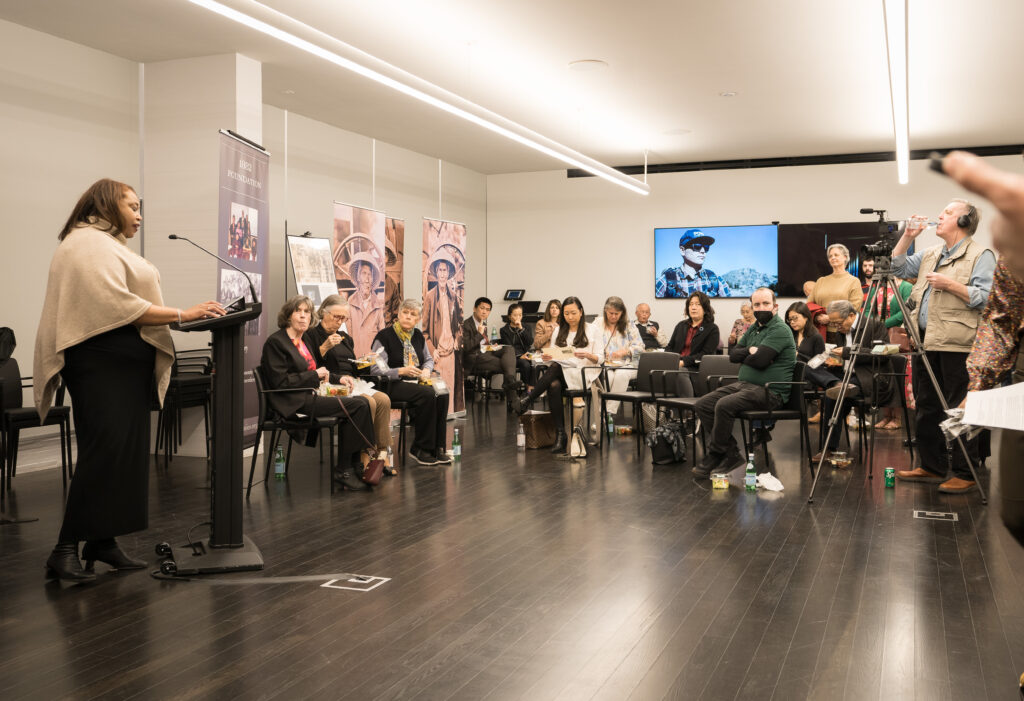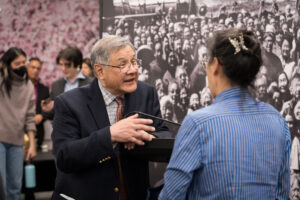 On March 21st, 2023, the 1882 Foundation convened our first activation as a member of the Kennedy Center’s Culture Caucus. We gathered at the Kennedy Center REACH’s Justice Forum on a warm Tuesday evening for a film screening and reception event. The activation was centered on the Summit Tunnel, a historic part of the Transcontinental Railroad constructed by largely unrecognized Chinese laborers. Despite the site being over 2,000 miles away, the sights, sounds, and ambiance of the Summit Tunnel was cultivated through film, the passion of our presenters, and the exhibition space displaying the faces of the workers and descendants who bring the site to life.
On March 21st, 2023, the 1882 Foundation convened our first activation as a member of the Kennedy Center’s Culture Caucus. We gathered at the Kennedy Center REACH’s Justice Forum on a warm Tuesday evening for a film screening and reception event. The activation was centered on the Summit Tunnel, a historic part of the Transcontinental Railroad constructed by largely unrecognized Chinese laborers. Despite the site being over 2,000 miles away, the sights, sounds, and ambiance of the Summit Tunnel was cultivated through film, the passion of our presenters, and the exhibition space displaying the faces of the workers and descendants who bring the site to life.
Ted Gong (1882 Foundation) and Tres McMichaels (Kennedy Center Social Impact) opened our event with remarks about the 1882 Foundation, Culture Caucus, and the power of the arts to inspire and encourage outcomes in public history, storytelling, and historic preservation. As a member of the Culture Caucus, the 1882 Foundation will present four activations at the Kennedy Center REACH over the next two years. The Summit Tunnel – Diversity and Pride is our first event, and aims to bring attention to the multifaceted importance of the Summit Tunnel and recommends its designation as a National Historic Landmark.
Legacy gives an overview of the history of Summit Tunnel #6, the site in Donner, CA where Chinese laborers worked to blast through the unforgiving granite of the Sierra Nevada mountains as part of the Transcontinental Railroad, the first of its kind to join rail systems in the Eastern United States to tracks on the West Coast. Subject matter experts Ted Gong, Phil Sexton, and Sue Lee detailed the monumental undertaking that this task was at the time of its construction and the brutal conditions under which it was accomplished, leading to the death of many Chinese workers. Finally, the film hears testimony from several descendants of Chinese railroad workers as they explore their relationship to the Summit Tunnel as a key site of their family’s history in the United States, begging the question of how we might continue to memorialize the Summit Tunnel as an exceptional part of the Chinese American experience. Legacy is directed by Joe Flannery and was produced with support from the USDA and the US Forest Service.
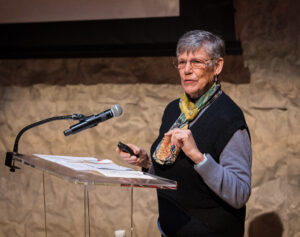 Next, we heard from Pat Malberg, president of the Donner Summit Historical Society, who described her family’s ties to Donner and preservation work underway at the site to deter graffiti artists and urban explorers from damaging the site. Many of the techniques used to fight graffiti are effective, such as repainting, special slippery coatings, or sandblasting, but also incur negative outcomes. Vandals see the cleared rocks as a blank canvas to re-tag, the coatings are expensive, and sandblasting removes a layer of the rock underneath the paint, meaning that the actual rocks that laborers on the Transcontinental Railroad might have touched are irreparably changed. Lastly, she explored some of the possibilities that would further protect the Summit Tunnel site, such as historic designation and further placemaking work that would generate more visitation to the Summit Tunnel and increase its presence.
Next, we heard from Pat Malberg, president of the Donner Summit Historical Society, who described her family’s ties to Donner and preservation work underway at the site to deter graffiti artists and urban explorers from damaging the site. Many of the techniques used to fight graffiti are effective, such as repainting, special slippery coatings, or sandblasting, but also incur negative outcomes. Vandals see the cleared rocks as a blank canvas to re-tag, the coatings are expensive, and sandblasting removes a layer of the rock underneath the paint, meaning that the actual rocks that laborers on the Transcontinental Railroad might have touched are irreparably changed. Lastly, she explored some of the possibilities that would further protect the Summit Tunnel site, such as historic designation and further placemaking work that would generate more visitation to the Summit Tunnel and increase its presence.
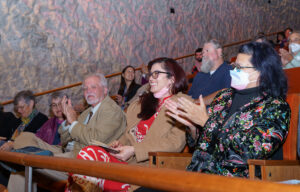 Tracing History gives an intimate look at a mother-daughter duo of Chinese railroad worker descendants who travel together to the Summit Tunnel to explore their roots. Traveling by foot and car across California, they explore and reflect on their own relationship as they walk the tunnels, find artifacts of rural Chinatowns, and enjoy the natural beauty of the site. Both the director and her mother, Jalena Keane-Lee and Miko Lee, in were in attendance, marking an especially meaningful screening and portraying an example of how Chinese American descendants engage with and come to understand the legacy of the Chinese workers of the Summit Tunnel. Tracing History is directed by Jalena Keane-Lee, Breaktide Productions. Its screening at the Justice Forum was its debut.
Tracing History gives an intimate look at a mother-daughter duo of Chinese railroad worker descendants who travel together to the Summit Tunnel to explore their roots. Traveling by foot and car across California, they explore and reflect on their own relationship as they walk the tunnels, find artifacts of rural Chinatowns, and enjoy the natural beauty of the site. Both the director and her mother, Jalena Keane-Lee and Miko Lee, in were in attendance, marking an especially meaningful screening and portraying an example of how Chinese American descendants engage with and come to understand the legacy of the Chinese workers of the Summit Tunnel. Tracing History is directed by Jalena Keane-Lee, Breaktide Productions. Its screening at the Justice Forum was its debut.
In the lobby between the Justice Forum and PT-109, Zhi Lin’s 2013 installation Chinaman’s Chance was screened to bridge the themes presented by our speakers to the reception. In the video of the installation, the famous joining of the trains at Promontory Point, Utah is recreated from the back view. Viewers see the progression of the famed moment throughout history from the rear, speaking to the theme of Chinese exclusion from the commemoration of their work. In front of the projection, hundreds of rocks from the site at scattered, bearing the names of workers who built the Summit Tunnel.
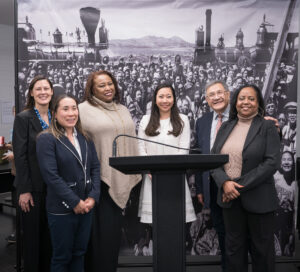 We moved into the exhibit and reception space, PT-109, where attendees could mingle with invited subject matter experts, enjoy light refreshments, and hear from several speakers. Angela Coleman, Associate Chief of the United States Forest Service, gave remarks on the importance of equity and inclusion of a diverse range of experiences in America’s natural sites. She recognized that the Summit Tunnel site is severely endangered as a historic site, and that interpretive work is key to continuing to honor its legacy. Krystal Ka’ai, Executive Director of the White House Initiative on Asian American Native Hawaiian Pacific Islanders (WHIAANHPI), spoke on the importance of historic sites like the Summit Tunnel and public education on the Asian American experience on combating anti-Asian racism. Ka’ai also shared some exciting new appointments of Asian Americans to public office by President Biden. Lastly, Ted Gong read a statement provided by Congresswoman Judy Chu, who could not join us at the Kennedy Center but sent along remarks acknowledging her own ancestry among the Transcontinental Railroad laborers and commending the work of the 1882 Foundation.
We moved into the exhibit and reception space, PT-109, where attendees could mingle with invited subject matter experts, enjoy light refreshments, and hear from several speakers. Angela Coleman, Associate Chief of the United States Forest Service, gave remarks on the importance of equity and inclusion of a diverse range of experiences in America’s natural sites. She recognized that the Summit Tunnel site is severely endangered as a historic site, and that interpretive work is key to continuing to honor its legacy. Krystal Ka’ai, Executive Director of the White House Initiative on Asian American Native Hawaiian Pacific Islanders (WHIAANHPI), spoke on the importance of historic sites like the Summit Tunnel and public education on the Asian American experience on combating anti-Asian racism. Ka’ai also shared some exciting new appointments of Asian Americans to public office by President Biden. Lastly, Ted Gong read a statement provided by Congresswoman Judy Chu, who could not join us at the Kennedy Center but sent along remarks acknowledging her own ancestry among the Transcontinental Railroad laborers and commending the work of the 1882 Foundation.
Watch the entirety of the activation below. Special thanks to Douglas Ross and Jack Yan for their help in documenting our event.

